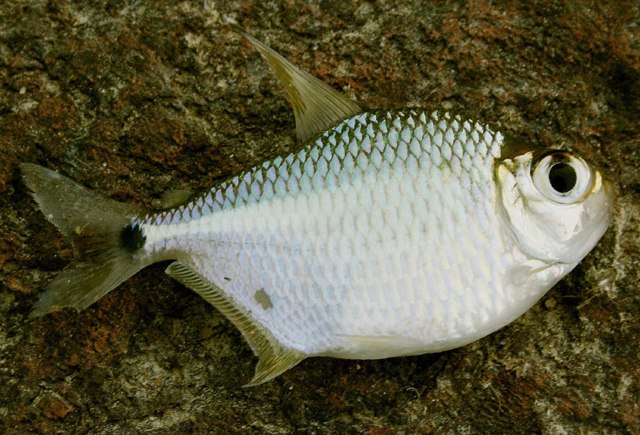| Characidae (Characins; tetras), subfamily: Tetragonopterinae |
| 12.7 cm TL (male/unsexed); max.weight: 40.2 g |
|
pelagic; freshwater; pH range: 5 - 7.5; dH range: 20 |
| South America: Amazon basin (including rio Tocantins), Orinoco and the Atlantic drainages of the Guianas (Essequibo, Corantijn and Marowijne river basins). |
|
Dorsal soft rays (total): 9-9; Anal soft rays: 26-33; Vertebrae: 30-31. This species is distinguished from T. anostomus, T. denticulatus, T. juruena, T. kuluene by the principal teeth on dentary 4 (vs. 5-6), and having larger and more robust teeth (vs. thinner and sharper teeth); differs from T. anostomus, T. araguaiensis by the gill-rakers on lower limb of the first gill arch 11-14 (vs. 17-20); differs from T. carvalhoi by the rounded dark mark on the caudal peduncle (vs. lozenge-shaped); differs from T. anostomus by having a terminal mouth (vs. subsuperior); differs from T. anostomus, T. kuluene by the conspicuous humeral marks 2 (vs. 1); differs from T. argenteus by the predorsal scales 7-9 (vs. 11-17); differs from T. franciscoensis by the number of olfactory lamellae 20-40 (vs. 11-17) and by having more robust teeth on dentary (vs. thinner and sharper teeth); differs from T. denticulatus by having humeral marks separated by a single vertical scale row (vs. marks separated by three vertical scale rows); differs from T. rarus by lacking the longitudinal dark stripes on the trunk (vs. presence); differs from T. rarus, T. georgiae by the scale rows between lateral line and pelvic fin origin 3.5 (vs. 4.5-5.5); differs from T. ommatus by the teeth on the maxilla 1-4 (vs. 7-8) and by having a conspicuous dark mark on the caudal peduncle (vs. inconspicuous and limited to the posterior part of the caudal peduncle) (Ref. 124043) |
| Occurs in creeks with rapidly flowing water over sandy areas and slow flowing water over plant debris (Ref. 12225). |
|
Least Concern (LC); Date assessed: 04 March 2021 Ref. (130435)
|
| harmless |
Source and more info: www.fishbase.org. For personal, classroom, and other internal use only. Not for publication.

